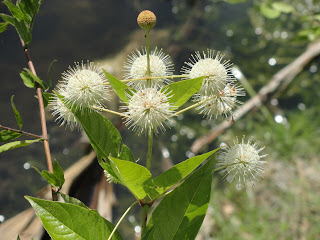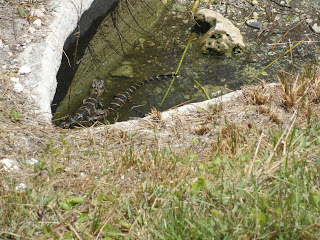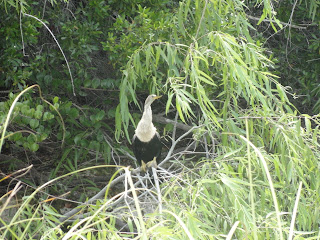THIS IS A LONG ONE SO RELAX A LITTLE AND GET A CUP OF SODA BEFORE YOU START. IT WAS A LOOOONG DAY FOR US, THUS A LOOOOONG BLOG!
Today, Tuesday, May 3, was a long and site filled day. We left camp before 8:00 AM, without eating breakfast to get down the road a little without the "Love Bugs". Helped a little, but not much. We stopped a few miles down the road at a wide pull off and had breakfast. As we looked around we saw we were across the road from a not so well marked trail called Big Cypress Bend. We donned our bug spray and hats and off we went.
We were well rewarded for our efforts. It was a beautiful trail and boardwalk that went back into the dense jungle of the everglades. It was amazing. The bug spray helped but did not keep them from buzzing around us.
We felt like we were in an Amazon like jungle and we were totally alone on the walk. Apparently, the bugs and poor signage does not make it a well frequented trail.
There were little signs along the trail that explained to us what we were seeing. This is a strangulation tree. It starts as a seedling in the top of the host tree and then grows its roots downward, surrounding the tree as it does. As its roots reach the soil, it gains new strength and tightens its grip on its host, eventually killing it. Its a jungle out there!!!
Here's another one we saw later. Beautiful, but deadly.... to its host anyway. They do not strangle humans!!!
Here is a healthy Royal Palm. A beautiful tree and our favorite as far as beauty goes. Our other favorite is the date palm. Yummy!! Oh, the Royal Palm is edible too. Its top crest is harvested and eaten like a cabbage!
The end of the trail....with a surprise!
Look closely. What do you see staring back at you??? Something we were going to be seeing a lot of as we headed deeper into the Everglades!
We really enjoyed these little signs. By the way, even though it was very hot, even being early in the morning, notice the mosquito influenced clothing?
Beautiful jungle!
We saw a red shouldered hawk as we walked. The western states has the red tailed hawk, the Everglades has the red shouldered hawk!!
Then we headed south into the Big Cypress National Preserve... we actually haven't gotten to the Everglades National Park yet...but this is all part of what used to be the everglades all south of Wauchula, FL.
We learned that there are many different parts of the Everglades. It is not all swamp, especially in May, the end of the dry season. June-November is the rainy season down here. The dry season is January-May.
The panthers are an endangered animal here in the Everglades due to poaching and being hit by autos, so they remind the traveler often to be on the look out for them.
This is the first one we saw!
The grasshoppers here are very colorful!!! There are several varieties, each equally different and colorful. Oh, they are big too!
Ann. always monkeying around!!
We found several more trails to walk along as we headed south and then east. Each with its own set of flora and fauna! Here is a soft shelled turtle, a favorite dinner for the alligator!
And we began seeing more and more of these fascinating critters!
The flowers here are even different than elsewhere in the world!
Dis I mention we began seeing more alligators today?
We were told that there was tons of wildlife at theis spot, but it required.....
... a several mile drive down a dirt road...........
......but all we found were two rangers and a not so populated lake.
We had been noticing there was a fire eat of us and the smoke was blowing our way. On one of the numerous trails we hiked today we saw a sign board describing and warning us of the fire. We were fascinated by the name of the fire. It had the same name as a nickname for one of our sons. Know which son it was??
The red line was Hwy 41 on which we were headed east, towards the fire, the red splotch on the east side of the map.
Though it was warning us of dangers of the trails we were walking, we still hikes several more today, but as we got closer to the fire, it became necessary to cease our explorations. We found it a topic of conversation about the forest fires we had been in in Alaska and Canada a few months back and here we are in Florida, dealing with them again.
The boardwalks became our favorites because they got you further back into the wilds of things without having to damage the area to get there. Thus many diverse parts of the Everglades were available for our viewing
Isn't this beautiful!!!!
Here we learned that this area is covered by several feet of water through most of the wet season and the roots for these trees have adapted to it.
Leaning over a railing, we saw that the traffic of the alligators is in no way impeded by the foot bridges of man. Can you see the alligator track? After awhile, we got where we could recognize alligator trails and other markings left by them. Fascinating!!!
There are many plants that take advantage of other plants as hosts. Some end up killing the host. This plant though, an air plant, just lodges in the trees branches, no damage to the tree. It has a beautiful flower that we will put in the blog later.
Some trails lead to or follow areas where the drought stricken Everglades keeps water for the alligators, and boy do they congregate there!!
We stopped at Monroe Station along Hwy 41 to watch the comings and goings at the command station for the Jarhead Fire. It was interesting!
Oh, did I mention we were seeing more and more alligators? We have stopped going in any water now!
In a Visitors Center we stopped at, we learned more about the "panther". This one was killed by a motorist as it crossed the highway and was stuffed for the parks service to remind motorists to slow down and keep an eye out for them. This one and the large sculpture we saw earlier were the only ones we saw that whole time we were here.
Much of the Everglades is dry this time of year, but during the wet season, this area is a slow flowing river about 1 inch deep and dozens of miles wide, all flowing to the south towards the southern tip of Florida and the Atlantic Ocean.
That clump of willows you see in the distance is made by alligators. As they dig down in the dry season for water, they hollow out an area. With the small pool they make there, trees begin to grow, animals are attracted to the water, more alligators show up and they make it bigger. It eventually becomes an oasis in the dry Everglades during the dry season. They are all over the savannas of the Everglades!
Here is one closer.
More Everglades
The entrance to the alligator's oasis.
Some birds that venture this close to the water's edge, become alligator food!
This is called a borrow pond. It now provides water and shelter for animals during the dry season. But is was originally made by man. They dug out these channels from the beneath the sod, harvesting the limestone to build the roads through here, before environmental protection got its start.
The limestone.
Near the Miccosukee Indian Reservation there was a place in the Everglades National Park that had originally been an 8 mile road back to an oil drilling site. They were unsuccessful and the National Parks Service now has it. They use the road through the Everglades to conduct tours via a tram. To avoid negative environmental impact, only pedestrians, bicyclists and the ranger run tram are allowed back in there. For a fee, you can take this 2 hour tour. We did. It was well worth it!!
Here is the retired 3rd grade teacher teaching the retired 4th grade teacher some everglade information.
Fellow tram travelers.
Our tour guide and her husband giving us our wonderfully guided tour.
Baby alligators.
More baby alligators.
The tower at the end of the road, half way through the tram tour. This was where the oil rig was once. The view from the top was well worth the climb!
Oh, and we saw a few alligators too!
More alligator food!
As we drove further east on hwy 41 and left the National Park, we traveled on a road that was made from the dredgings of the the borrow pit to the left and witnessed the construction of an elevated causeway to the right that will eventually allow drivers to drive above the Everglades and thus allowing animals to pass underneath rather than getting hit as they migrate to and from their water source.
As we turned south on Hwy 997 we began seeing more and more cultivated land, just outside the National Park boundaries. We felt like we were in Hawaii with all the banana orchards.
And there were also palm orchards everywhere!!!
The we pulled into the town of Homestead where there were as many trees as there were people. On the outskirts of town there were many fruit and vegetable stands selling the produce of the hundreds of farms and orchards. It was amazing and the prices were very good.... can't say that about the prices of diesel. $4.25 a gallon!!!!
Finally, we headed west on Hwy 9336 back into the Park! We werre tired and ready to find our campsite!
With a flash of our annual pass we purchased back in New Mexico, we entered free and half price for the camping fees!!
Ahhhh! Our campground!
Different type of surroundings, no hookups, but secure and very much alone. Only 4 or 5 other campers in the whole campground.
Our long rig was a little too much for the spaces here, so we put our trusty orange cone out for all to see we were there! It was cooler here and slightly less buggy. But, Ann was still attacked as she has been for the last several days. She is quite welted. Wayne eats so much garlic and onions that his bad breath seems to keep them a little at bay from him.
A beautiful sunset in the Everglades National Park, ends the long long day!



































































No comments:
Post a Comment